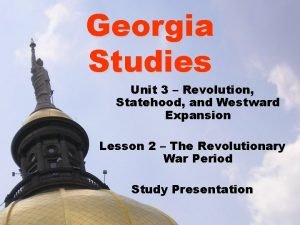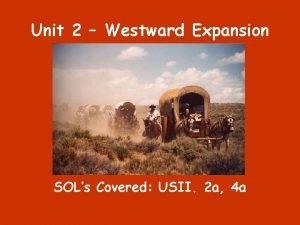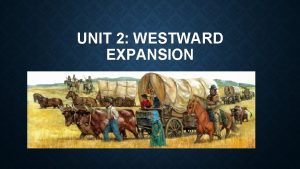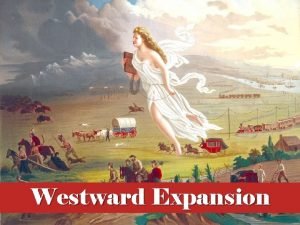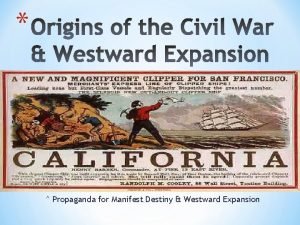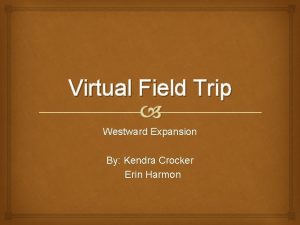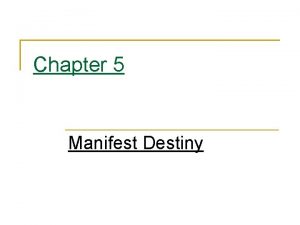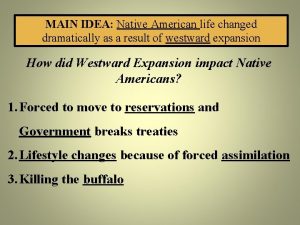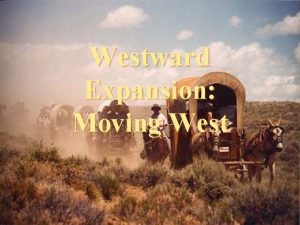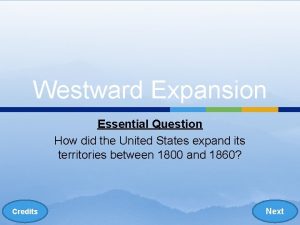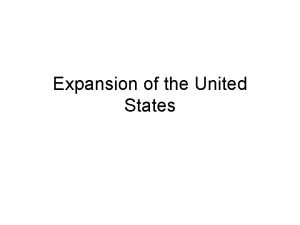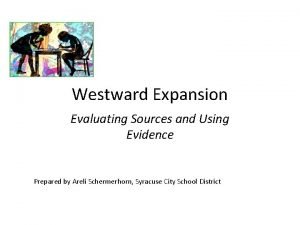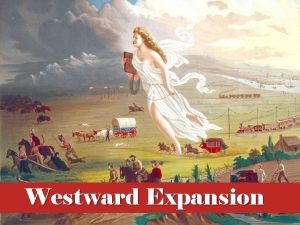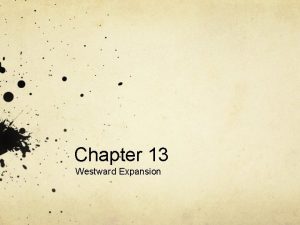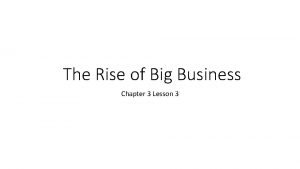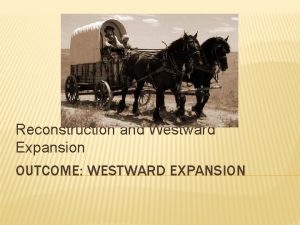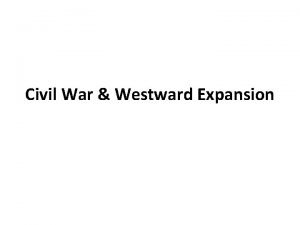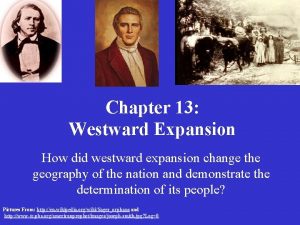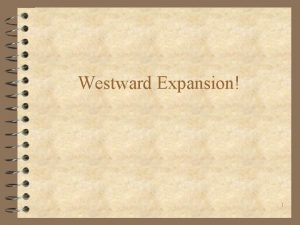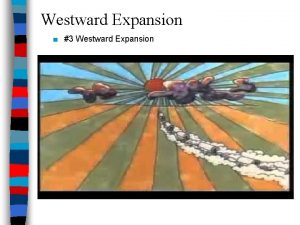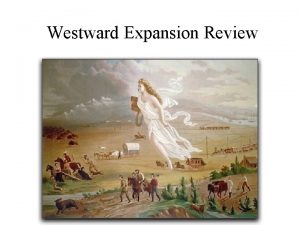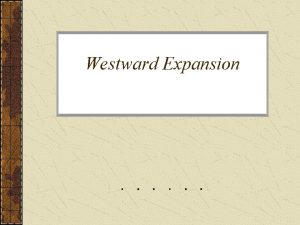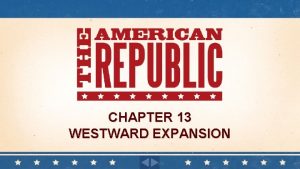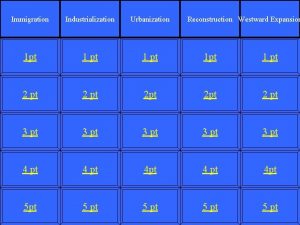Unit Westward Expansion and Industrialization Lesson Westward Expansion





























- Slides: 29

Unit: Westward Expansion and Industrialization Lesson: Westward Expansion and American Indians DLT: I can identify and analyze significant events for Native Americans and their response to those events during the late nineteenth century.

The Trail of Tears • Trail of Tears: 1830 s the federal government and President Andrew Jackson forced Native Americans to resettle west of the Mississippi River. • Native Americans in the west were promised “land forever. ” • 1834 law was passed that limited the access of white people in Indian Territory. • End of the Civil War (1865) almost 250, 000 Indians lived west of the Mississippi River in the “Great American Desert”.

Diverse Cultures • Pacific Northwest -- fishing and forest animals. • South—hunter-gatherers. • New Mexico/Arizona —irrigation and farming. Built homes high on cliffs to protect themselves from neighbors. • Mobile Tribes —(Navajos)– lived in tepees that could be moved easily. • Plains Indians—(Soiux, Blackfeet, Crows Cheyenne)— horsemen and buffalo hunters. Natives shared one common thread: they all saw themselves as part of nature and saw nature as sacred. Contrast: many white people saw nature as a resource used to produce wealth.


After the Trail of Tears The discovery of gold and silver inside the Indian Territory in the 1850 s changed things. Many white settlers followed the railroad out west. (Railroads were harmful to Indians. ) The government redirected Indians to smaller portions of land. Reservations: specific areas set aside by the government for Indian use.


Fall of the Indians and Sorrow of the Buffalo Settlers did three main things that weakened the American Indians: 1. Settlers forced Indians onto reservations. 2. Introduced new diseases. 3. In the 1870 s setters began slaughtering 100 s of buffalo a day for sport. Skinned buffalo for their hides and left the meat to rot.

Sand Creek Massacre • 1862 (during Civil War) Sioux had resisted threats to their land by attacking settlements in east Minnesota and were pushed into the Dakotas. • The government staged full-scale war on the Sioux. • Plains Indians raised American flags to show neutrality—many were killed anyway. • People were outraged at Officer John Chivington, the event came to be called the Sand Creek Massacre. • "Kill and scalp all, big and little; nits make lice. "

Silas Soule Born to an abolitionist family. Refused to shoot at Sand Creek.

After the Civil War Regiments of troops –White and African American—were recruited to fight against the American Indian. They were promised “horses or other plunder” taken from the American Indian.

Attempts at Peace Fail • 1866 – U. S. government announced plan to build road through Sioux lands in MN. • Captain William Fetterman and 100+ U. S. soldiers murdered by Red Cloud and Sioux in Fetterman Massacre. • 1868 – Ft. Laramie, WY Treaty said US would not build road & would leave 3 forts if Sioux would live on reservation with support from federal government. • Both sides violated the treaty.

Approaching the Battle of Little Big Horn • Black Hills God Rush of 1875 drew prospectors into Sioux hunting grounds. • Sioux, led by Crazy Horse and Sitting Bull, assembled to drive the prospectors out. • The US Army sent troops to fight the Sioux. Sitting Bull Crazy Horse

General Alfred Terry Union general in the American Civil War and the military commander of the Dakota Territory.

General George Custer Head of the 7 th Cavalry. Daring and dashing soldier, who had won high honors as a division commander during the Civil War, and who had developed a reputation as an Indian fighter.

The Original Plan: Battle of Little Big Horn • Terry commanded Custer to scout the area. • Terry planned to send Custer to hold the Sioux from the east, while he and other troops pushed up the Yellowstone in boats. • They would then march southward until they reached Sitting Bull, as a group.

“Custer’s Last Stand” June 25, 1876 • Custer rode through the night to get there one day early (25 th). 60 miles in 24 hours. • Custer, with 250 men, approached at least 2, 000 Indians. • Crazy Horse led the charge that became known as “Custer’s Last Stand”. • When Terry came up on the 26 th he found Custer and all of his men dead. • Crook had over 2, 000 men only 30 miles to Custer's left. If Custer had been scouting he would have run into Crook, and Crook could have reinforced him. The Battle of Little Big Horn was the last major Indian victory in the west.

Comanche- The only US Army Survivor at the Battle of Little Big Horn. As a tribute to his service and bravery, the war horse Comanche was never ridden again. He lived to the age of 29, and when he died his body was mounted and put on display at the University of Kansas, where it stands to this day.


“CNN: Custer's last flag: Banner carried at Little Bighorn sells for $2. 2 M” http: //i. cdn. turner. com/cnn/2010/US/06/25/custer. flag/story. c uster. flag. sothebys. jpg

“Bury My Heart at Wounded Knee” • “Setting the Indian on the course to civilization best ensures his survival, ” -President Ulysses S. Grant

Red Cloud Henry Dawes Ulysses S Grant Charles Eastman Sitting Bull Elaine Goodale Wovoka

Chief Joseph and the Nez Perce • Pacific N. W. tribe of Wallowa Valley, OR; land wanted by white farmers • 1876 -77 Joseph was forced to retreat on a 1100 mile march for Canada • He was stopped Sept. 1877 only 40 miles from Canada at Big Hole Basin, MT • Joseph surrendered Oct. 5 th, 1877 & tribe was banished to reservation in Indian Territory in OK • Sioux Chief Crazy Horse was murdered 1 month earlier to the day by US soldier while in captivity.

Ghost Dance • Many Indians welcomed a religious revival based on the Ghost Dance. • Ghost Dance was intended to banish white settlers and bring back the buffalo. • As the movement spread US government officials became concerned it may spread.

Massacre at Wounded Knee (1890) • 1890, the government ordered the arrest of Sitting Bull. • Sitting Bull and several others were killed. • Hostilities broke out at Wounded Knee, South Dakota, when the well-armed 7 th Calvary met unarmed Indians. • This was the last major sad event in the Indian Wars as their fate was sealed. The Massacre at Wounded Knee: Soldiers of the 7 th Calvary killed nearly 200 unarmed Sioux Indians.

Native American Culture Destroyed • 1860 - 13 million buffalo to 1000 est. in 1900! • Surviving Native Americans forced onto reservations • 1881 - Helen Hunt Jackson’s A Century of Dishonor spawned the “Indian Rights” movement

Criminal Code of 1884 • Indians prohibited from practicing tribal religions (Ghost Dance Movement led to Wounded Knee Massacre (1890)

The End of the Indian Wars • After the Indian Wars the Indians were forced to move west or north to live on reservations. • Settlers believed they had a greater right to western land than the American Indian because settlers produced more food and wealth than the Indians.

Dawes General Allotment Act Goal: Assimilation of American Indians. Government wanted American Indians to assimilate, adopt the culture and way of life of the whites. Allotment System: each family was given a 160 -acre farmstead. • The government wanted Indians to live on reservations and farm individual plots. • Hoped that when children were born onto the allotted plots they would adopt white culture and way of life.

Carlisle Indian Industrial School • PA boarding school for Native Americans that required them to learn English and abandon their culture and religion. Its goal too was assimilation.
 Unit 3 rev. statehood and westward expansion
Unit 3 rev. statehood and westward expansion Unit 2 westward expansion vocabulary
Unit 2 westward expansion vocabulary Unit 2 westward expansion vocabulary
Unit 2 westward expansion vocabulary Westward expansion lewis and clark
Westward expansion lewis and clark Westward expansion discussion questions
Westward expansion discussion questions Westward expansion vocabulary words
Westward expansion vocabulary words Westward expansion acrostic poem
Westward expansion acrostic poem California gold rush advertisement
California gold rush advertisement A trip westward question and answer
A trip westward question and answer American historama lewis and clark
American historama lewis and clark American expansion westward/manifest destiny
American expansion westward/manifest destiny How did westward expansion increase sectional tensions
How did westward expansion increase sectional tensions Westward expansion wagon
Westward expansion wagon Westward expansion vocabulary
Westward expansion vocabulary Effects of westward expansion
Effects of westward expansion Assimilation westward expansion
Assimilation westward expansion Great plains westward expansion
Great plains westward expansion Westward expansion thesis statement
Westward expansion thesis statement Westward expansion essential questions
Westward expansion essential questions Westward expansion map
Westward expansion map Westward expansion
Westward expansion Westward expansion essential questions
Westward expansion essential questions Gilded age westward expansion
Gilded age westward expansion Chapter 13 westward expansion
Chapter 13 westward expansion Chapter 10 lesson 1 the industrial revolution
Chapter 10 lesson 1 the industrial revolution Chapter 10 lesson 1 the industrial revolution
Chapter 10 lesson 1 the industrial revolution Revolution
Revolution Lesson 5 - industrialization
Lesson 5 - industrialization Lesson 3 big business and government
Lesson 3 big business and government Hyp opp adj triangle
Hyp opp adj triangle
